Pectoral Strain
Updated:
(Also known as Torn Pectoral, Pec Strain, Pectoral Muscle Strain, Strained Pectoral, Pectoral Tear)
What is a pectoral strain?
A pectoral strain is a condition characterised by partial or complete tearing of one or more of the pectoral (chest) muscles (figure 1).
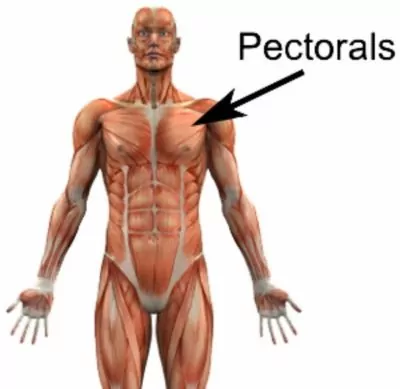
The pectoral muscles are a group of two muscles situated at the front of the chest (figure 1). The largest of which is the pectoralis major muscle which originates from the sternum (breast bone), ribs and collar bone and attaches to the upper arm bone (humerus). The pectoralis minor is the smaller of the two pectoral muscles originating from the front of the ribs and attaching to a bony process at the front of the shoulder blade. The pectoral muscles are responsible for assisting with movements of the shoulder blade and shoulder (such as pushing movements and taking the arm across the chest).
During stretch or contraction of the pectorals, tension is placed through the pectoral muscles and tendons. When this tension is excessive due to too much repetition or high force, one or more of the pectoral muscles can tear. This condition is known as a pectoral strain.
Tears to the pectoral muscles can range from a small partial tear whereby there is minimal pain and minimal loss of function, to a complete rupture. Pectoral strains range from a grade 1 to a grade 3 tear and are classified as follows:
- Grade 1: a small number of fibers are torn resulting in some pain, but allowing full function.
- Grade 2: a significant number of fibers are torn with moderate loss of function.
- Grade 3: all muscle fibers are ruptured resulting in major loss of function.
The majority of pectoral strains are grade 2 tears.
Causes of a pectoral strain
A pectoral strain often occurs suddenly due to a high force going through the muscle and tendon beyond what it can withstand. This typically occurs during weight training especially when performing a bench press, chest press or pectoral flys (especially with free weights).
Sometimes a pectoral strain may develop over time due to repetitive or prolonged activities placing strain on the pectoral muscles. This may cause gradual degeneration and weakening of the pectorals predisposing them to further injury. Pectoral strains tend to occur more commonly in the older athlete and particularly following an inadequate warm-up.
Signs and symptoms of a pectoral strain
Patients with a pectoral strain will often experience a sudden pain or tearing sensation in the chest or front of the shoulder during the provocative activity. In minor cases, patients may be able to continue sport or activity only to have an increase in pain and stiffness upon resting later (particularly that night or the following morning). In severe cases the pain may be disabling, preventing the patient from performing further activity.
Patients with a pectoral strain usually experience pain that is localized to the chest and front of the shoulder or arm pit. Occasionally, pain may radiate into the upper arm or neck. The pain associated with a pectoral strain is usually experienced as an ache that increases to a sharper pain with activity.
Patients will usually experience pain when firmly touching the affected pectoral muscle and often when attempting to stretch the pectoral muscles or perform activities requiring strong contraction of the pectoral muscles such as pushing activities or taking the arm across the chest against resistance. Bruising, swelling, muscle spasm and weakness may also be experienced.
In patients with a minor pectoral tear, little or no symptoms may be present. In these patients, a minor ache or tightness may be the only complaint. In severe or chronic cases, muscle wasting and a palpable hole (or noticeable deformity) in the muscle may be detected corresponding to the location of the tear.
Diagnosis of a pectoral strain
A thorough subjective and objective examination from a physiotherapist is usually sufficient to diagnose a pectoral strain. Further investigations such as an X-Ray, Ultrasound, CT scan or MRI scan may be required to confirm diagnosis, rule out other conditions and assess the severity of injury.
Treatment for a pectoral strain

Members Only ContentBecome a PhysioAdvisor Member to gain full access to this exclusive content. For more details see Become a Member. Already a member? Login Now
Prognosis of a pectoral strain
With appropriate management, most minor to moderate cases of a pectoral strain that have not been present for long can usually recover within a number of weeks. In more severe or chronic cases recovery can be a lengthy process and may take many weeks to months to achieve an optimal outcome. Those patients with a complete pectoral tear that requires surgery, usually require a period of rehabilitation of 3 – 9 months or longer before returning to full activity.
Contributing factors to the development of a pectoral strain
There are several factors which can predispose patients to developing a pectoral strain. These need to be assessed and corrected with direction from a physiotherapist. Some of these factors include:
- abnormal biomechanics (eg. poor weight lifting / bench press technique, throwing technique etc)
- neck, upper back and shoulder stiffness
- muscle imbalances
- inadequate conditioning of the pectoral muscles
- muscle weakness (especially the pectoral muscles, rotator cuff or scapular stabilisers)
- muscle tightness
- poor posture
- excessive or inappropriate training or activity
- inadequate recovery periods from sport or activity
- inadequate warm up
- fatigue
- inadequate rehabilitation following a previous pectoral injury
Physiotherapy for a pectoral strain
Physiotherapy treatment for a pectoral strain is vital to hasten the healing process and ensure an optimal outcome. Treatment may comprise:
- soft tissue massage
- electrotherapy (e.g. ultrasound)
- joint mobilization
- joint manipulation
- dry needling
- ice or heat treatment
- the use of a sling
- progressive exercises to improve flexibility, strength and posture
- education
- training and activity modification advice
- technique correction
- postural correction
- anti-inflammatory advice
- devising and monitoring a return to sport or activity plan
Other intervention for a pectoral strain
Despite appropriate physiotherapy management, some patients with a pectoral strain do not improve. When this occurs the treating physiotherapist or doctor can advise on the best course of management. This may include further investigations such as X-rays, ultrasound, CT scan or MRI, pharmaceutical intervention, corticosteroid injection, autologous blood injection or referral to appropriate medical authorities who can advise on any intervention that may be appropriate to improve the condition. In rare cases of complete pectoralis major muscle rupture, surgical intervention may be indicated.
Exercises for a pectoral strain
The following exercises are commonly prescribed to patients with this condition. You should discuss the suitability of these exercises with your physiotherapist prior to beginning them. Generally, they should be performed 1 – 3 times daily and only provided they do not cause or increase symptoms.
Your physiotherapist can advise when it is appropriate to begin the initial exercises and eventually progress to the intermediate, advanced and other exercises. As a general rule, addition of exercises or progression to more advanced exercises should take place gradually and provided there is no increase in symptoms.
Initial Exercises
Static Pectoral Push In
Begin this exercise standing with your back and neck straight and your shoulders back slightly. Keeping your elbow at your side and bent to 90 degrees, push your hand in against the other hands resistance as hard as possible provided the exercise is pain free (figure 2). Hold for 5 seconds and repeat 10 times.
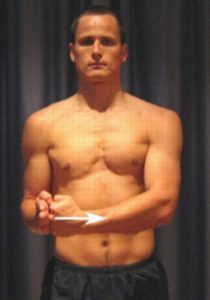
Shoulder External Rotation
Begin standing tall, with your neck and back straight, your shoulders should be back slightly. Keeping your elbow tucked into your side and bent to 90 degrees, gently take your hand away from your body as far as you can go without pain and provided you feel no more than a mild to moderate stretch (figure 3). Repeat 10 times provided the exercise is pain free.
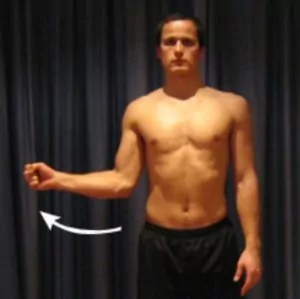
Shoulder Flexion
Begin standing tall with your back and neck straight. Gently raise your arm forwards and up as far as you can go without pain and provided you feel no more than a mild to moderate stretch (figure 4). Repeat 10 times provided the exercise is pain free.
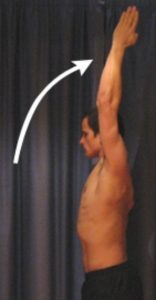
Intermediate Exercises

Members Only ContentBecome a PhysioAdvisor Member to gain full access to this exclusive content. For more details see Become a Member. Already a member? Login Now
Advanced Exercises

Members Only ContentBecome a PhysioAdvisor Member to gain full access to this exclusive content. For more details see Become a Member. Already a member? Login Now
Other Exercises

Members Only ContentBecome a PhysioAdvisor Member to gain full access to this exclusive content. For more details see Become a Member. Already a member? Login Now
Rehabilitation Protocol for a pectoral strain

Members Only ContentBecome a PhysioAdvisor Member to gain full access to this exclusive content. For more details see Become a Member. Already a member? Login Now
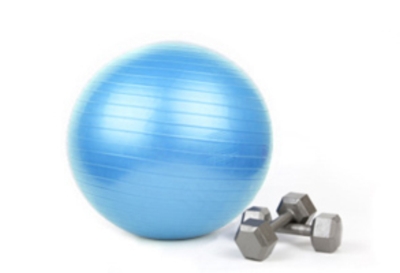 Physiotherapy products for a pectoral strain
Physiotherapy products for a pectoral strain
Some of the most commonly recommended products by physiotherapists to hasten healing and speed recovery in patients with this condition include:
To purchase physiotherapy products for a pectoral strain, click on one of the above links or visit the PhysioAdvisor Shop.
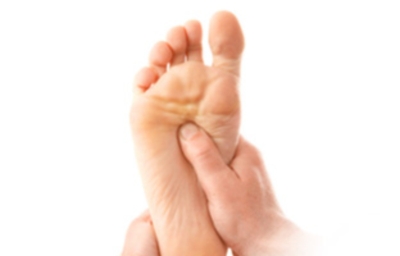 Find a Physio
Find a Physio
Find a physiotherapist in your local area who can treat a pectoral strain.
 Other Exercises
Other Exercises
- View more Pectoral Strengthening Exercises.
- View more Pectoral Stretches
- View Upper Body Foam Roller Exercises
- View Upper Body Massage Ball Exercises
- View Upper Body Resistance Band Exercises
- View Upper Body Gym Exercises
- View Arm Stretches
- View Arm Strengthening Exercises
 More information
More information
- View detailed information on when to use Ice or Heat
- View detailed information on initial injury management and the R.I.C.E. Regime.
- View detailed information on Warming Up & Cooling Down.
- View detailed information on Returning to Sport.
- Read our Shoulder Diagnosis Guide.
Become a PhysioAdvisor Member

Link to this Page
If you would like to link to this article on your website, simply copy the code below and add it to your page:
<a href="https://physioadvisor.com.au/injuries/shoulder/pectoral-strain”>Pectoral Strain – PhysioAdvisor.com</a><br/>PhysioAdvisor offers detailed physiotherapy information on a pectoral strain including: causes, symptoms, diagnosis, treatment, exercises, physiotherapy products and more...
Return to the top of Pectoral Strain.











